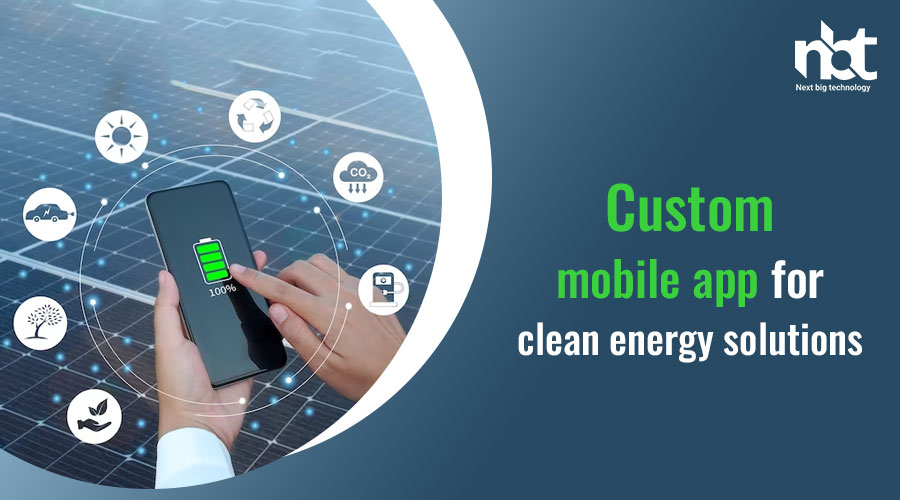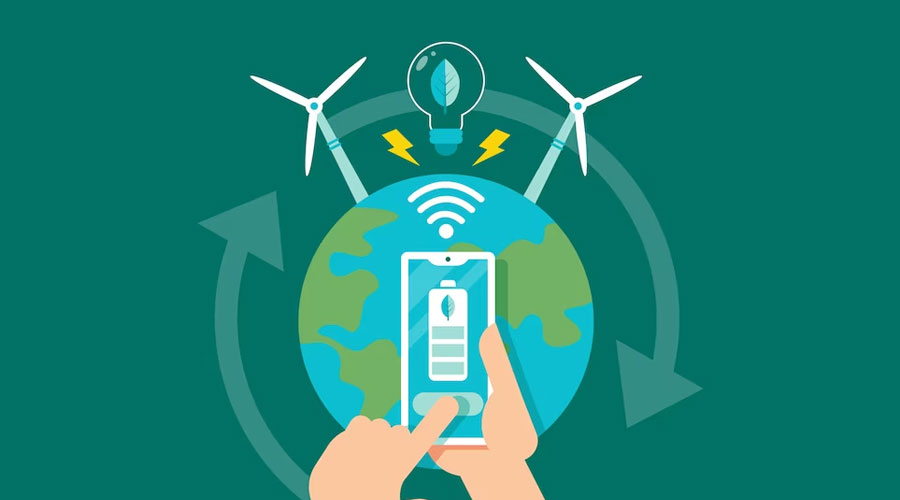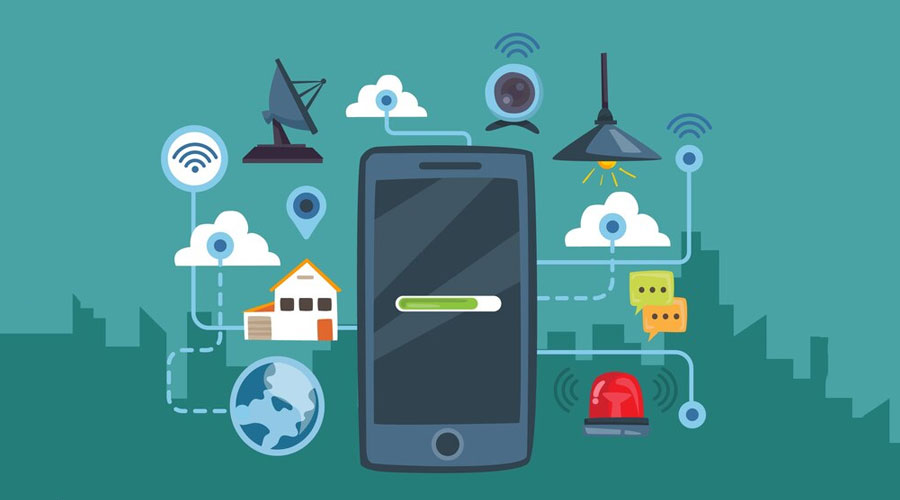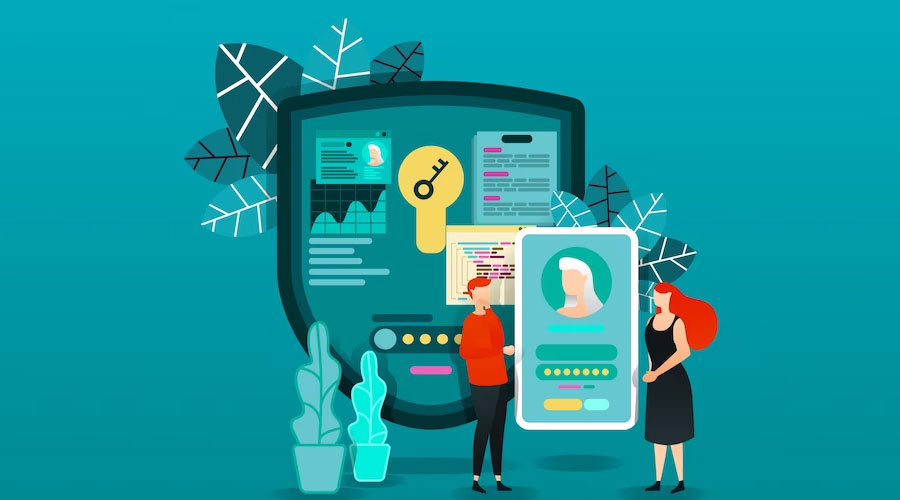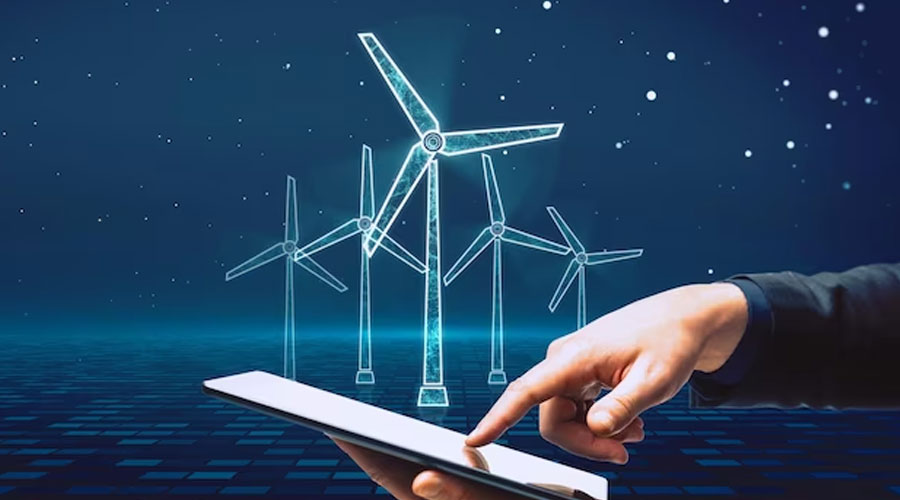Table of Contents
Introduction to Custom Mobile Apps in the Clean Energy Sector
The global pursuit of a sustainable future has intensified in recent years, driven by concerns over climate change, resource scarcity, and environmental degradation. As part of this global effort, the clean energy sector has witnessed remarkable advancements, transforming the way we generate, consume, and manage energy. Central to this transformation is the emergence of custom mobile apps tailored to address the unique needs of the clean energy industry.
Custom mobile apps have become a pivotal force in facilitating the transition to cleaner and more sustainable energy solutions. Their ability to harness the power of mobile technology, real-time data, and user engagement has opened up new horizons for both individuals and businesses to actively participate in the clean energy revolution. In this supplemental introduction, we delve deeper into the clean energy sector’s evolution and the role of custom mobile apps in propelling this transformation.
The Clean Energy Imperative
The urgency of addressing the challenges posed by traditional fossil fuel-based energy sources cannot be overstated. The burning of fossil fuels not only contributes significantly to greenhouse gas emissions, but it also depletes finite natural resources and harms ecosystems. The imperative to shift towards clean energy alternatives is driven by several key factors:
- Environmental Concerns: The environmental consequences of fossil fuel consumption are evident in rising global temperatures, extreme weather events, and habitat destruction. Clean energy solutions aim to mitigate these impacts.
- Resource Depletion: Fossil fuels are finite resources, and their extraction and consumption are depleting these reserves rapidly. Clean energy sources, such as solar, wind, and hydroelectric power, are renewable and sustainable.
- Energy Security: Reliance on fossil fuels is a geopolitical and economic vulnerability for many nations. Clean energy sources offer a more secure and diversified energy supply.
- Economic Opportunities: The clean energy sector presents significant economic opportunities, from job creation to the development of innovative technologies.
The Evolution of Clean Energy Solutions
The journey towards clean energy has seen remarkable advancements and breakthroughs. Some key milestones in the evolution of clean energy solutions include:
- Renewable Energy Sources: The increasing use of renewable energy sources like solar, wind, and hydroelectric power has reduced our dependence on fossil fuels. These sources are abundant, sustainable, and produce minimal emissions.
- Energy Efficiency: Advances in energy-efficient technologies have enabled homes and businesses to reduce energy consumption. LED lighting, smart appliances, and building automation systems are just a few examples.
- Electric Vehicles (EVs): The adoption of electric vehicles has gained momentum as battery technology improves and charging infrastructure expands. EVs offer a cleaner alternative to traditional gas-powered vehicles.
- Energy Storage: The development of energy storage solutions, including lithium-ion batteries, has made it possible to store excess energy generated from renewable sources for later use.
- Grid Modernization: Smart grid technologies allow for more efficient energy distribution and demand response. They enable real-time monitoring and management of energy flows.
- Sustainable Practices: Industries and individuals are increasingly adopting sustainable practices, such as recycling, energy conservation, and reducing waste.
Custom Mobile Apps in the Clean Energy Sector
The convergence of digital technology with clean energy solutions has given rise to a new era of innovation. Custom mobile apps, designed to address the unique challenges and opportunities in the clean energy sector, have become a vital component of this transformation. Here are some key aspects of their role:
- Accessibility and Engagement: Custom mobile apps provide an accessible platform for users to engage with clean energy solutions. They offer real-time information and interactive features that empower individuals to take an active role in sustainable energy practices.
- Data Collection and Analysis: These apps collect and analyze data related to energy consumption and production. This data-driven approach allows for better decision-making and optimization of energy usage.
- Education and Awareness: Custom mobile apps serve as educational tools, raising awareness about clean energy practices and their environmental impact. They provide information, resources, and real-world examples to inform and inspire users.
- Integration with Smart Devices: The integration of mobile apps with smart devices and home automation systems enables users to remotely control and monitor energy usage. This integration enhances convenience and energy efficiency.
- Incentives and Rewards: To motivate sustainable behavior, these apps often include gamification elements and rewards. Users can earn incentives for reducing energy consumption or adopting clean energy sources.
The Role of Custom Mobile Apps in Sustainability
Custom mobile apps in the clean energy sector are not mere technological novelties; they are powerful instruments of change. Their impact on sustainability extends to several key areas:
- Individual Empowerment: These apps empower individuals to take control of their energy consumption and make informed decisions. By providing real-time data and personalized recommendations, they enable users to reduce their carbon footprint.
- Energy Efficiency: Real-time monitoring and energy-saving tips offered by custom apps contribute to improved energy efficiency. This, in turn, reduces overall energy demand and environmental impact.
- Renewable Energy Adoption: Mobile apps promote the adoption of renewable energy sources by connecting users with green energy providers and calculating potential cost savings and environmental benefits.
- Data-Driven Decision-Making: The data collected and analyzed by these apps play a crucial role in informing energy providers, policymakers, and businesses. It enables evidence-based decisions for the development of cleaner energy solutions.
- Environmental Education: Custom mobile apps contribute to environmental education by providing information and resources. They help users understand the implications of their energy choices and encourage the adoption of sustainable practices.
- Community Building: Many custom apps foster a sense of community among users who share clean energy interests. This community engagement can lead to collective initiatives and a greater impact on sustainability.
In this rapidly evolving landscape, custom mobile apps have the potential to revolutionize the clean energy sector and accelerate the transition to sustainable energy sources. They represent a critical bridge between technology and sustainability, enabling individuals, businesses, and communities to actively participate in the clean energy revolution. As we delve deeper into the multifaceted world of custom mobile apps for clean energy solutions, we will explore their key functionalities, the development process, and their broader impact on environmental sustainability.
This supplemental introduction offers an overview of the clean energy imperative and the transformative power of custom mobile apps. As we proceed, we will delve into the intricacies of these apps, their development, and the ways in which they are driving sustainability in the clean energy sector.
The Role of Mobile Apps in Advancing Clean Energy Solutions
Mobile apps have played a pivotal role in advancing clean energy solutions by providing innovative and user-friendly platforms that empower individuals, businesses, and communities to participate actively in the transition to a sustainable and eco-friendly future. In this addition, we will delve deeper into the specific ways in which mobile apps contribute to the advancement of clean energy solutions.
-
Real-time Energy Monitoring
One of the fundamental contributions of mobile apps to clean energy solutions is their ability to provide real-time energy monitoring. These apps connect to smart meters, sensors, and other data sources to offer users up-to-the-minute information about their energy consumption. This feature is instrumental in helping individuals and organizations identify energy wastage and inefficiencies, enabling them to take immediate corrective actions to reduce energy consumption and costs. The continuous feedback loop created by real-time monitoring encourages users to adopt energy-efficient practices.
-
Access to Renewable Energy Sources
Mobile apps facilitate access to renewable energy sources, such as solar and wind energy. Users can find information about local green energy providers, community solar projects, and even government incentives for adopting renewable energy technologies. By connecting users with these sustainable energy sources, mobile apps play a vital role in promoting the use of clean and renewable energy, which is a key component of sustainable living and reducing carbon emissions.
-
Carbon Footprint Calculation and Reduction
Mobile apps often incorporate tools to calculate and track users’ carbon footprints. By inputting data about their energy consumption and transportation habits, users can gain insights into their environmental impact. These apps then offer recommendations on how to reduce their carbon footprint. This may include suggestions for energy-efficient appliances, transportation alternatives, and lifestyle changes. By making individuals aware of their environmental impact and providing actionable steps to reduce it, mobile apps actively contribute to clean energy solutions.
-
Energy Efficiency Tips and Recommendations
Custom mobile apps for clean energy provide users with personalized energy efficiency tips and recommendations. These tips take into account the specific circumstances and preferences of the user. For example, an app can suggest energy-efficient lighting solutions or heating and cooling settings based on the user’s location, weather conditions, and energy consumption patterns. By offering tailored advice, mobile apps empower users to make immediate changes that result in reduced energy consumption and costs.
-
Integration with Smart Devices
The integration of mobile apps with smart devices and home automation systems is another critical aspect of advancing clean energy solutions. Users can control and monitor their smart appliances, heating, and lighting remotely through the app. For instance, they can adjust the thermostat or turn off lights when not needed. This level of control allows for optimized energy use and enables users to align their consumption with renewable energy production, reducing their environmental impact.
-
Bill and Cost Analysis
Mobile apps also provide features for analyzing energy bills and costs. Users can input their energy rates, and the app can calculate projected costs based on historical usage data. This helps users budget more effectively and make informed decisions about energy consumption. Additionally, the app can suggest cost-saving measures, such as shifting energy-intensive tasks to off-peak hours or taking advantage of incentive programs offered by local utilities.
-
Incentive Programs and Rewards
Many mobile apps for clean energy incorporate incentive programs and rewards to motivate users to adopt energy-efficient and sustainable practices. These programs may include gamification elements, challenges, and rewards for achieving energy-saving goals. Users can earn points, discounts, or other incentives for their participation, making sustainable practices more attractive and engaging.
-
Community Engagement
Mobile apps can foster community engagement by connecting like-minded individuals and organizations interested in clean energy solutions. These apps often include forums, chat rooms, and social features that allow users to share their experiences, tips, and success stories. The sense of community created by these apps can lead to collective initiatives, such as community solar projects or neighborhood energy challenges, which can have a significant impact on advancing clean energy at the local level.
Key Features and Functionality of Custom Clean Energy Mobile Apps
In addition to the core features and functionalities discussed in the previous section, custom clean energy mobile apps can incorporate several advanced and innovative features that further enhance their utility and impact on sustainability. These add-on features can contribute to a more comprehensive and user-centric clean energy solution. Below are some key add-on features and functionalities for custom clean energy mobile apps:
-
Energy Forecasting:
Energy forecasting features can provide users with predictions about their future energy consumption and production based on historical data, weather forecasts, and user patterns. This can help users plan their energy usage more efficiently, especially when incorporating renewable energy sources like solar panels.
-
Smart Grid Integration:
Integration with smart grid technology allows the app to tap into the wider energy network and leverage real-time data from power utilities. Users can benefit from more accurate information about energy demand and pricing, enabling them to make cost-effective decisions.
-
Carbon Offset Calculations:
In addition to calculating carbon footprints, apps can provide options for users to offset their emissions by investing in carbon reduction projects, such as reforestation or renewable energy initiatives. Users can track their offset contributions and understand their environmental impact.
-
Energy Storage Management:
For users with energy storage solutions like batteries, the app can provide tools to optimize energy storage and discharge patterns. This ensures that renewable energy is effectively stored and used during peak demand periods or power outages.
-
Virtual Reality (VR) and Augmented Reality (AR) Simulations:
Advanced apps can incorporate VR and AR elements to offer immersive experiences for users. For example, users can visualize their energy consumption and its environmental impact in a virtual environment, fostering a deeper understanding of clean energy practices.
-
Predictive Maintenance:
For users with renewable energy systems like solar panels or wind turbines, predictive maintenance features can predict potential equipment failures and provide timely alerts. This ensures that clean energy systems operate efficiently and have a longer lifespan.
-
Energy Trading:
In cases where users generate excess energy from renewable sources, the app can facilitate energy trading within a community or with the grid. This feature allows users to sell surplus energy and gain economic benefits.
-
Gamification Challenges:
To make the app more engaging and encourage clean energy adoption, gamification features like challenges, leaderboards, and rewards can be integrated. Users can compete with friends or other users to achieve energy-saving goals.
-
Social Integration:
Social media integration allows users to share their clean energy achievements and activities with their networks. This can promote a sense of community and encourage more people to participate in sustainable practices.
-
Environmental Impact Assessments:
Advanced apps can provide detailed assessments of a user’s environmental impact beyond just carbon emissions. This can include analyses of water conservation, waste reduction, and biodiversity preservation, offering a more holistic view of sustainability.
-
Automated Energy Efficiency Recommendations:
Using machine learning and artificial intelligence, the app can offer personalized and automated energy efficiency recommendations based on user behavior and data analysis. These recommendations can continually adapt to the user’s preferences and habits.
-
Home Energy Audits:
Apps can guide users through DIY home energy audits, helping them identify areas for improvement in energy efficiency. Users can receive customized reports with suggestions for upgrades and retrofits.
-
In-App Marketplace:
An in-app marketplace can connect users with sustainable products, energy-efficient appliances, and green building materials. It can also feature partnerships with local clean energy service providers for easy access to green services.
-
Green Transportation Integration:
To promote sustainable mobility, the app can integrate features related to electric vehicle charging stations, public transportation options, and ride-sharing services that prioritize clean energy usage.
-
Multilingual Support:
To reach a global audience, apps can incorporate multilingual support to make their content and features accessible to users around the world.
-
Educational Mini-Games:
Educational mini-games can be designed to teach users about clean energy concepts in a fun and interactive way. This feature is particularly useful for engaging younger audiences.
Custom clean energy mobile apps are dynamic platforms that can evolve to meet the ever-changing demands of users and the clean energy landscape. These additional features enhance user engagement, promote sustainable practices, and foster a deeper connection between individuals and clean energy solutions. Tailoring the app’s functionalities to the specific needs of users ensures a more personalized and impactful approach to sustainability.
Benefits of Developing Custom Mobile Apps for Clean Energy
let’s delve deeper into the additional benefits of developing custom mobile apps for clean energy solutions. These benefits go beyond the significance, functionalities, and development process and further emphasize the advantages of embracing mobile technology in the clean energy sector.
-
Behavioral Insights and Gamification:
Custom mobile apps have the capability to provide valuable behavioral insights by tracking user interactions and energy-related activities. By analyzing this data, the app can offer personalized recommendations and interventions to encourage sustainable behavior. Gamification elements, such as achievement badges, challenges, and competitions, can motivate users to compete and collaborate in adopting clean energy practices.
-
Geolocation Services:
Mobile apps can utilize geolocation services to offer location-specific information and services. For example, users can receive alerts about local clean energy events, incentives, and discounts. They can also find nearby electric vehicle (EV) charging stations and green energy suppliers in their area.
-
Real-Time Notifications:
Custom mobile apps can send real-time notifications to users about various aspects of clean energy, including energy consumption spikes, renewable energy availability, or upcoming clean energy events. These notifications help users stay informed and make timely decisions to optimize their clean energy usage.
-
Energy Usage Forecasting:
Advanced machine learning and artificial intelligence algorithms can be incorporated into custom apps to forecast energy usage patterns. Users can receive predictive data that helps them plan energy-efficient actions, such as adjusting their thermostat settings or optimizing appliance usage during off-peak hours.
-
Integration with Electric Vehicles:
With the rise of electric vehicles (EVs), mobile apps can play a pivotal role in integrating EV charging and usage into the clean energy ecosystem. Users can locate nearby charging stations, check availability, and even schedule charging sessions through the app.
-
Energy Marketplace and Peer-to-Peer Trading:
Custom apps can establish energy marketplaces where users can buy and sell excess clean energy, fostering a peer-to-peer energy trading community. This enables individuals with renewable energy sources, such as solar panels, to share their surplus energy with neighbors or trade it for incentives.
-
Community-Sourced Data and Crowdsourcing:
These apps can leverage crowdsourcing to collect valuable data from users. For instance, users can report energy-related issues or suggest local clean energy initiatives. Community-sourced data can then be used to inform clean energy policies and practices.
-
Access to Government Incentives:
Mobile apps can provide information about government incentives and subsidies for clean energy adoption. Users can easily access details about tax credits, rebates, and other financial incentives available for energy-efficient upgrades, such as installing energy-efficient appliances or solar panels.
-
Data-Driven Policy Advocacy:
The aggregated data from these apps can be anonymized and shared with policymakers and energy organizations. This data can be used as a powerful tool for advocating and shaping policies that promote clean energy practices and sustainability.
-
Scalability and Adaptability:
Custom mobile apps are highly scalable and adaptable. As technology evolves and new clean energy solutions emerge, the app can be updated and expanded to accommodate new features and integrate with the latest energy-efficient technologies.
-
Reduced Administrative Overhead:
In a business or utility context, custom apps can significantly reduce administrative overhead by automating tasks such as energy bill analysis, customer support, and reporting. This can lead to cost savings and operational efficiency.
-
Enhanced User Engagement and Loyalty:
Engaging users through a custom mobile app builds customer loyalty. Users who feel connected to an app’s community and derive value from it are more likely to continue using the app and advocating for clean energy practices.
-
Impact Measurement and Reporting:
Custom mobile apps can track and report the cumulative environmental impact of their users. This data can be used to showcase the collective efforts of the app’s user base, highlighting the significant positive impact on reducing carbon emissions.
Case Studies: Successful Custom Mobile Apps in Clean Energy
To gain a deeper understanding of the impact and potential of custom mobile apps in the clean energy sector, let’s explore a few case studies showcasing successful applications in this domain. These real-world examples demonstrate how custom mobile apps have been utilized to promote clean energy adoption, enhance energy efficiency, and contribute to a more sustainable future.
-
SolarEdge Monitoring Platform
Objective: SolarEdge Technologies, a global leader in smart energy, developed a custom mobile app to monitor and optimize the performance of solar energy systems.
Key Features:
- Real-time monitoring of solar energy production.
- Visualization of energy consumption and savings.
- Alerts and notifications for system issues.
- Remote control of smart energy devices.
Impact: The SolarEdge mobile app has empowered homeowners and businesses to maximize their solar energy generation. Users can monitor their energy production and consumption, making it easier to identify opportunities for energy savings. The app’s ability to provide real-time alerts for system issues has also minimized downtime, ensuring that solar installations operate efficiently. With over 2.5 million monitored systems, SolarEdge’s app has played a crucial role in advancing the adoption of solar energy.
-
Nest by Google
Objective: Nest, a subsidiary of Google, developed a suite of smart home products, including a custom mobile app, to enhance energy efficiency and reduce energy consumption in households.
Key Features:
- Thermostat control for precise temperature management.
- Integration with smart lighting and appliances.
- Learning algorithm to optimize energy usage.
- Energy usage reports and insights.
Impact: Nest’s mobile app has transformed how users manage energy within their homes. The smart thermostat and integrated ecosystem of devices allow users to fine-tune their energy consumption by automating heating, cooling, and lighting systems. The app’s learning algorithm adapts to user preferences, resulting in energy savings. Nest has helped users reduce their carbon footprint while enjoying the convenience of a connected and energy-efficient home.
-
SolarCoin Mobile Wallet
Objective: SolarCoin Foundation, a cryptocurrency initiative, introduced a mobile app to reward solar energy producers with a digital currency (SolarCoins) for each megawatt-hour of solar electricity generated.
Key Features:
- Solar energy production verification.
- Digital wallet for storing SolarCoins.
- Real-time SolarCoin earnings tracking.
- Integration with solar energy production data.
Impact: The SolarCoin mobile app has incentivized solar energy generation by providing a financial reward for producers. It not only encourages the adoption of solar power but also verifies the production of clean energy through blockchain technology. The app has created a global community of solar energy producers who earn SolarCoins for their contribution to clean energy. As of [date], over [number] megawatt-hours of solar energy have been rewarded with SolarCoins.
-
Arcadia Power
Objective: Arcadia Power developed a mobile app to connect consumers with renewable energy sources and enable them to make environmentally conscious choices about their electricity supply.
Key Features:
- Renewable energy plan sign-up and management.
- Bill analysis and comparison tools.
- Carbon footprint tracking.
- Community engagement features.
Impact: Arcadia Power’s mobile app has simplified the process of accessing renewable energy for consumers. Users can switch to clean energy plans, track their carbon footprint, and engage with like-minded individuals in their community. The app empowers individuals to choose clean energy without the need for solar panels or wind turbines on their property. It has led to an increase in the adoption of renewable energy plans and a growing community of eco-conscious consumers.
-
The JouleBug App
Objective: JouleBug designed a gamified mobile app to motivate individuals and communities to adopt sustainable practices, including energy conservation.
Key Features:
- Sustainable challenges and achievements.
- Energy-saving tips and actions.
- Social sharing and community competitions.
- Real-world rewards for eco-friendly actions.
Impact: The JouleBug app uses gamification to encourage users to adopt sustainable behaviors, including energy-saving practices. Users earn points and badges for completing eco-friendly actions, such as turning off lights when not in use or reducing water consumption. The app fosters a sense of community by allowing users to share their achievements and compete in sustainability challenges. JouleBug has successfully engaged a wide audience in sustainable practices, promoting clean energy adoption as part of a broader sustainability movement.
These case studies illustrate the diverse applications of custom mobile apps in the clean energy sector. From solar energy monitoring to smart home management and cryptocurrency incentives, these apps have played a crucial role in advancing the adoption of clean energy practices, promoting energy efficiency, and contributing to a more sustainable future. The success of these apps demonstrates their potential to drive positive change and empower individuals and communities to make environmentally conscious choices.
By leveraging the capabilities of mobile technology, these innovative solutions have opened up new avenues for clean energy adoption and sustainability, marking significant progress towards a greener and more environmentally responsible future.
Future Trends and Innovations in Clean Energy Mobile Apps
As clean energy solutions continue to gain traction in the pursuit of a more sustainable future, mobile apps play a pivotal role in shaping how we engage with and adopt these solutions. Keeping an eye on emerging trends and innovations in clean energy mobile apps is essential to stay ahead in the race toward a greener world. In this section, we explore some of the exciting future trends and innovations that are expected to shape the landscape of clean energy mobile apps.
-
Artificial Intelligence (AI) and Machine Learning Integration
Artificial intelligence and machine learning are expected to play a significant role in clean energy apps of the future. These technologies can provide intelligent insights into energy consumption patterns, offer personalized recommendations for energy efficiency, and optimize the operation of clean energy systems. For instance, AI can predict when energy demand will be high and help users schedule energy-intensive tasks during off-peak hours, reducing costs and environmental impact.
-
Internet of Things (IoT) Connectivity
The Internet of Things is a game-changer in the clean energy space. IoT-enabled devices, such as smart thermostats, energy-efficient appliances, and home automation systems, can seamlessly connect with clean energy mobile apps. This connectivity allows users to remotely monitor and control their energy usage in real-time, making adjustments for optimal efficiency. Furthermore, IoT devices can gather data on energy consumption and share it with the app for in-depth analysis.
-
Blockchain for Energy Transactions
Blockchain technology is making inroads into the clean energy sector, enabling transparent and secure energy transactions. Clean energy apps can use blockchain to facilitate peer-to-peer energy trading. Users can buy and sell excess energy generated from renewable sources with others in their community, promoting the use of clean energy and reducing dependency on traditional utilities.
-
Augmented Reality (AR) and Virtual Reality (VR) for Energy Education
Clean energy mobile apps can harness augmented reality and virtual reality to provide immersive educational experiences. Users can step into virtual environments to learn about clean energy technologies, tour solar farms, or explore wind turbine facilities. These technologies can make learning about clean energy more engaging and accessible.
-
Gamification and Rewards
Gamification has been a successful feature in many mobile apps, and its application in clean energy apps is expected to grow. Apps can turn energy-saving activities into a game, rewarding users for meeting efficiency goals. These rewards can include virtual badges, real-world incentives, or charitable donations to environmental causes, fostering a sense of accomplishment and encouraging users to continue their sustainable practices.
-
Energy Communities and Peer Networks
Clean energy mobile apps can evolve into platforms for building energy communities and networks. Users can connect with like-minded individuals and share experiences, tips, and success stories. Peer networks can also lead to collective initiatives, such as group purchases of solar panels, further accelerating the adoption of clean energy.
-
Advanced Predictive Analytics
Future clean energy apps will likely incorporate more advanced predictive analytics. By analyzing historical data and user behavior, these apps can offer predictive insights into future energy costs and consumption patterns. This empowers users to make informed decisions, such as when to invest in solar panels or how to optimize their energy use for cost savings and environmental benefits.
-
Regulatory Compliance and Reporting
As clean energy regulations become more stringent, mobile apps can help users navigate complex compliance requirements. They can generate reports and documentation needed for clean energy subsidies, tax credits, and other incentives, simplifying the process of adhering to government regulations.
-
Energy Market Integration
Clean energy mobile apps can integrate with energy markets and trading platforms, enabling users to participate in real-time energy markets. Users can buy and sell energy at market rates, providing opportunities to profit from surplus energy production and contribute to a more dynamic and efficient energy ecosystem.
-
AI-Enhanced Customer Support
AI-powered chatbots and virtual assistants are becoming more sophisticated. Future clean energy apps can use AI to provide personalized customer support, helping users troubleshoot issues with their clean energy systems, answer questions, and offer guidance on energy efficiency improvements.




